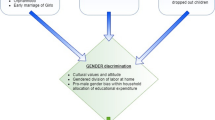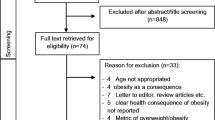Abstract
Background
Menarche is a substantial milestone of female puberty. Timing of age at menarche is considered the key to understanding the potential linkages with women’s health outcomes later in life. This study aimed to explore the secular trends and urban‒rural disparities in the median age at menarche among Chinese Han girls from 1985 to 2019.
Methods
Data were extracted from the 1985, 1995, 2005, 2014, and 2019 Chinese National Surveys on Students’ Constitution and Health, which were nationally representative cross-sectional studies, and a total of 173,535 Han girls aged 9–18 years were examined. Girls were asked whether menarche had occurred. The median age at menarche was estimated by probit analysis. Z tests were used to compare the differences between survey years and between urban and rural areas.
Results
The median age at menarche among Chinese Han girls decreased from 13.37 years in 1985 to 12.00 years in 2019, and the overall decrease was more significant in rural areas (1.77 years) than in urban areas (0.99 years). The average five-year change in the decrease in the median age at menarche showed an accelerating and then slowing pace; and it was observed similarly in both urban and rural areas. The urban‒rural disparities shrank from 0.64 years in 1985 to 0.44 years in 1995, then to 0.27 years in 2005, 0.24 years in 2014, and finally to − 0.14 years in 2019.
Conclusions
The median age at menarche among Chinese Han girls continued to decline from 1985 to 2019 but at a slowing pace in the last five years. Urban‒rural disparities gradually narrowed. Sexual and reproductive health education and interventions to prevent the decline in the age of menarche are needed, especially in rural areas.


Similar content being viewed by others
Data availability
The data analyzed in this study are subject to the following licenses/restrictions: All individual (de-identified) participant data collected in the surveys can be shared with investigators whose proposed use of the data has been approved by an independent review committee identified for this purpose by contacting the corresponding author. Proposals should be directed to songyi@bjmu.edu.cn.
References
Karapanou O, Papadimitriou A. Determinants of menarche. Reprod Biol Endocrinol. 2010;8:115.
Leone T, Brown LJ. Timing and determinants of age at menarche in low-income and middle-income countries. BMJ Glob Health. 2020;5:e003689.
Collaborative Group on Hormonal Factors in Breast Cancer. Menarche, menopause, and breast cancer risk: individual participant meta-analysis, including 118 964 women with breast cancer from 117 epidemiological studies. Lancet Oncol. 2012;13:1141–51.
Gong TT, Wu QJ, Vogtmann E, Lin B, Wang YL. Age at menarche and risk of ovarian cancer: a meta-analysis of epidemiological studies. Int J Cancer. 2013;132:2894–900.
Janghorbani M, Mansourian M, Hosseini E. Systematic review and meta-analysis of age at menarche and risk of type 2 diabetes. Acta Diabetol. 2014;51:519–28.
Prentice P, Viner RM. Pubertal timing and adult obesity and cardiometabolic risk in women and men: a systematic review and meta-analysis. Int J Obes (Lond). 2013;37:1036–43.
Sequeira ME, Lewis SJ, Bonilla C, Smith GD, Joinson C. Association of timing of menarche with depressive symptoms and depression in adolescence: mendelian randomisation study. Br J Psychiatry. 2017;210:39–46.
Gohlke B, Woelfle J. Growth and puberty in German children: is there still a positive secular trend? Dtsch Arztebl Int. 2009;106:377–82.
Wyshak G, Frisch RE. Evidence for a secular trend in age of menarche. N Engl J Med. 1982;306:1033–5.
Cho GJ, Park HT, Shin JH, Hur JY, Kim YT, Kim SH, et al. Age at menarche in a Korean population: secular trends and influencing factors. Eur J Pediatr. 2010;169:89–94.
Finer LB, Philbin JM. Trends in ages at key reproductive transitions in the United States, 1951–2010. Womens Health Issues. 2014;24:e271–9.
Gomula A, Koziel S. Secular trend and social variation in age at menarche among Polish schoolgirls before and after the political transformation. Am J Hum Biol. 2018;30:e23048.
Meng X, Li S, Duan W, Sun Y, Jia C. Secular trend of age at menarche in Chinese adolescents born from 1973 to 2004. Pediatrics. 2017;140:e20170085.
Song Y, Ma J, Wang HJ, Wang Z, Hu P, Zhang B, et al. Trends of age at menarche and association with body mass index in Chinese school-aged girls, 1985–2010. J Pediatr. 2014;165:1172-7.e1.
Deng Y, Liang J, Zong Y, Yu P, Xie R, Guo Y, et al. Timing of spermarche and menarche among urban students in Guangzhou, China: trends from 2005 to 2012 and association with Obesity. Sci Rep. 2018;8:263.
Liang J, Mai J, Yang W, Lin J, Yao Z. Median-age secular trend of first spermatorrhea and menarche among adolescents in Guangzhou city during 1985–2014. Chin J Sch Health. 2016;37:1670–2.
World Bank. World Bank Open Data. 2022. https://data.worldbank.org/. Accessed 10 Feb 2023.
National Buraeu of Statistics. National data. 2022. http://https--data--stats--gov--cn--e4192.proxy.www.stats.gov.cn/easyquery.htm?cn=C01. Accessed 10 Feb 2023.
Yan X, Liu Y, Ma N, Zhang J, Dang J, Hu P, et al. Regional inequality of height among Chinese Han students aged 7 to 18 years from 1985 to 2014. Chin J Prev Med. 2021;55:752–8.
Song Y, Agardh A, Ma J, Li L, Lei Y, Stafford RS, et al. National trends in stunting, thinness and overweight among Chinese school-aged children, 1985–2014. Int J Obes (Lond). 2019;43:402–11.
Duan R, Chen Y, Qiao T, Duan R, Chen M, Zhao L, et al. Modern dietary pattern is prospectively associated with earlier age at menarche: data from the CHNS 1997–2015. Nutr J. 2020;19:95.
Dong Y, Gao D, Li Y, Yang Z, Wang X, Chen M, et al. Effect of childhood phthalates exposure on the risk of overweight and obesity: a nested case-control study in China. Environ Int. 2022;158:106886.
Harley KG, Berger KP, Kogut K, Parra K, Lustig RH, Greenspan LC, et al. Association of phthalates, parabens and phenols found in personal care products with pubertal timing in girls and boys. Hum Reprod. 2019;34:109–17.
Mul D, Fredriks AM, van Buuren S, Oostdijk W, Verloove-Vanhorick SP, Wit JM. Pubertal development in The Netherlands 1965–1997. Pediatr Res. 2001;50:479–86.
Hosokawa M, Imazeki S, Mizunuma H, Kubota T, Hayashi K. Secular trends in age at menarche and time to establish regular menstrual cycling in Japanese women born between 1930 and 1985. BMC Womens Health. 2012;12:19.
Rigon F, Bianchin L, Bernasconi S, Bona G, Bozzola M, Buzi F, et al. Update on age at menarche in Italy: toward the leveling off of the secular trend. J Adolesc Health. 2010;46:238–44.
Parent AS, Teilmann G, Juul A, Skakkebaek NE, Toppari J, Bourguignon JP. The timing of normal puberty and the age limits of sexual precocity: variations around the world, secular trends, and changes after migration. Endocr Rev. 2003;24:668–93.
Tanner JM. Human growth: a comprehensive treatise volume 1 developmental biology prenatal growth. New York: Plenum Press, 1986.
de Muinich Keizer SM, Mul D. Trends in pubertal development in Europe. Hum Reprod Update. 2001;7:287–91.
Gong P, Liang S, Carlton EJ, Jiang Q, Wu J, Wang L, et al. Urbanisation and health in China. Lancet. 2012;379:843–52.
Dong Y, Ma Y, Dong B, Zou Z, Hu P, Wang Z, et al. Geographical variation and urban-rural disparity of overweight and obesity in Chinese school-aged children between 2010 and 2014: two successive national cross-sectional surveys. BMJ Open. 2019;9:e025559.
Deardorff J, Gonzales NA, Christopher FS, Roosa MW, Millsap RE. Early puberty and adolescent pregnancy: the influence of alcohol use. Pediatrics. 2005;116:1451–6.
Copeland W, Shanahan L, Miller S, Costello EJ, Angold A, Maughan B. Outcomes of early pubertal timing in young women: a prospective population-based study. Am J Psychiatry. 2010;167:1218–25.
Song Y, Ma J, Hu P, Zhang B. Geographic distribution and secular trends of menarche in 9–18 year-old Chinese Han girls. J Peking Univ Health Sci. 2011;43:360–4.
Acknowledgements
We would like to acknowledge the support from all team members and the participating students, parents, teachers, and local education and health staff in the program. And we would like to acknowledge Prof. Patrick W.C. Lau for proofreading the manuscript.
Funding
The present study was funded by National Natural Science Foundation (82273654 to Y.S.)
Author information
Authors and Affiliations
Contributions
NM: Conceptualization, Formal analysis, Writing—original draft, Writing—review & editing; YS: Conceptualization, Funding acquisition, Methodology, Project administration, Writing—review & editing; DS, JD, PZ, YL, SC, YD, PH, and JM: Writing—review & editing.
Corresponding author
Ethics declarations
Conflict of interest
No financial or non-financial benefits have been received or will be received from any party related directly or indirectly to the subject of this article.
Ethical approval
This study was approved by the Medical Research Ethics Committee of the Peking University Health Science Center (IRB00001052 -19095).
Additional information
Publisher's Note
Springer Nature remains neutral with regard to jurisdictional claims in published maps and institutional affiliations.
Rights and permissions
Springer Nature or its licensor (e.g. a society or other partner) holds exclusive rights to this article under a publishing agreement with the author(s) or other rightsholder(s); author self-archiving of the accepted manuscript version of this article is solely governed by the terms of such publishing agreement and applicable law.
About this article
Cite this article
Ma, N., Shi, D., Dang, JJ. et al. Secular trends and urban–rural disparities in the median age at menarche among Chinese han girls from 1985 to 2019. World J Pediatr 19, 1162–1168 (2023). https://doi.org/10.1007/s12519-023-00723-9
Received:
Accepted:
Published:
Issue Date:
DOI: https://doi.org/10.1007/s12519-023-00723-9




